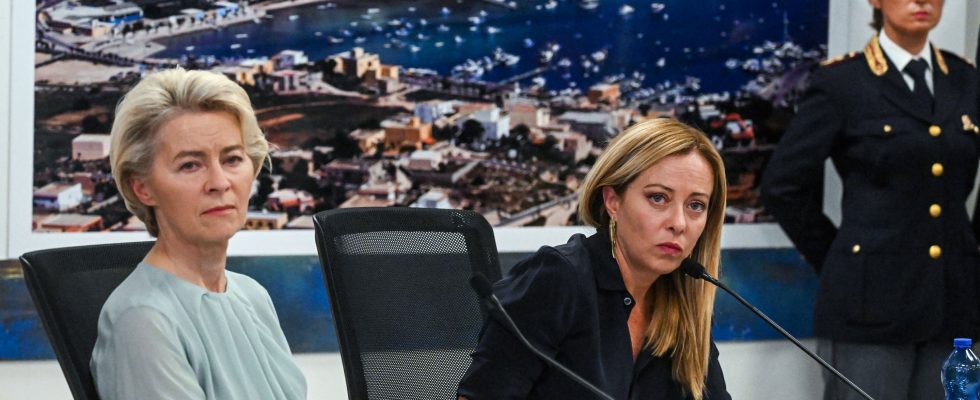The European Commission intends to take its responsibilities in this new migration crisis. This Sunday, September 17, its president Ursula von der Leyen presented an emergency plan to help Italy manage the record arrival of exiles on the Mediterranean island of Lampedusa.
An announcement made during his visit to the island’s migrant reception center, alongside far-right Italian Prime Minister Giorgia Meloni. Close to the Maghreb coast, Lampedusa has been facing an unprecedented influx of refugees since the start of the week: between Monday and Wednesday, more than 8,500 people arrived aboard 199 boats, according to figures from the United Nations High Commission. for Refugees (UNHCR). That is more than the entire population of the island.
As arrivals continued this Sunday, the President of the European Commission detailed a 10-point aid plan, intended as much to manage the current situation as to prevent the next crisis.
Distributing responsibilities within the EU
While the number of migrants attempting to cross the Mediterranean to Italy “has doubled compared to last year”, precise Euronewsthis agreement aims in particular for the European Union to take its responsibilities in the management of refugee arrivals.
This should first involve strengthening EU agencies. Brussels thus intends to strengthen assistance to Italy from the European Union Agency for Asylum (AUEA) and the European Coast Guard Agency (Frontex). And this, in particular to ensure the registration of arrivals, the taking of fingerprints, interviews and referral to the competent authorities.
The AUEA should also have more support in applying rapid border procedures, while several agencies such as Frontex will also have to intensify surveillance of the seas and “study options to expand its naval missions in the Mediterranean”.
Beyond the European agencies, the agreement announced by the Commission also aims for the 26 other countries of the Union to take their responsibilities in the Italian crisis, by facilitating the transfer of people who arrived in Lampedusa to their territories. Ursula von der Leyen thus urged on Sunday “other Member States to use the voluntary solidarity mechanism”, in particular for unaccompanied minors and women, as cited in the second point of the agreement.
More cooperation with emigration states
All eyes are on Western Europe: at the very beginning of the wave of arrivals of migrants in Lampedusa, Berlin announced on Monday its refusal to receive new exiles arriving from Italy, accusing Rome of not respecting its own reception obligations. Likewise, the mayor of the island Filippo Mannino said that same day he was “concerned by the refusal of countries like France and Germany to accept migrant quotas. Europe cannot abandon us to our destiny”, according to the Italian daily Corriere della Sera.
While the Commission is struggling to obtain cooperation from its Member States, the plan announced this Sunday plans to strengthen cooperation with the main emigration countries on the route to Italy, with a view to the readmission of their citizens whose asylum application would not be accepted. The agreement specifically cites Guinea, Ivory Coast, Senegal and Burkina Faso.
In addition to strengthening the fight against illegal networks, the commission wishes to “increase awareness and communication campaigns” in these countries, in order to “dissuade Mediterranean crossings”. Despite everything, the European plan also aims to continue “working to offer alternatives such as humanitarian admission and legal channels” of immigration. And this, by promising more cooperation with the Office of the High Commissioner for Refugees and the International Organization for Migration of the UN.
This 10-point plan also provides for agreements with countries of origin and transit in order to curb the number of departures. Particularly with Tunisia, at the center of this crisis: it is from this country, closest to the island of Lampedusa, that the majority of exiles embark for the Italian island.
An agreement with an authoritarian Tunisia already criticized
This type of agreement has already taken place between Tunis and Brussels: in July, the European Union signed a partnership with Tunisia intended to reduce the arrival of migrants in Italy, in exchange for financial aid worth several million euros. Ursula von der Leyen also estimated on Sunday that the EU should accelerate the payment of this aid, while the Italian Prime Minister raised the possibility of a European envelope to help Tunisia complete its budget.
This is a sensitive subject for the European Commission, while the Tunisian president with authoritarian practices spoke in February of “hordes of illegal migrants” arriving as part of a “criminal plan to change the composition of the demographic landscape in Tunisia. Wednesday, the European Union ombudsman Emily O’Reilly thus alerted Ursula von der Leyen that “where fundamental rights are not respected, there can be no good administration”, in a letter cited by the English edition of Politico.
Like the migration agreement with Turkey during the 2015 crisis, Emily O’Reilly believes that the EU risks finding itself dependent and responsible for the actions of a country whose respect for the rights of exiles is with variable geometry.
